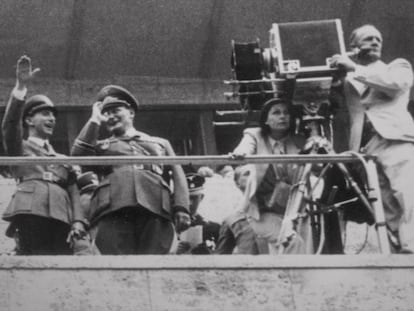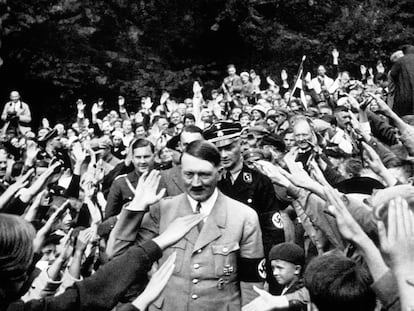The SS nursery: Novelist recreates the Nazi maternity wards where babies were raised to swell the ranks of Himmler’s order
Belgian writer Caroline De Mulder, in a fascinating and terrifying work, describes the workings of the Lebensborn households in ‘Himmler’s Children’


It’s hard to associate the Schutzstaffel (SS) with cots, swaddles and diapers, and their leader, Heinrich Himmler, is farm more likely to be seen visiting Auschwitz, Dachau, or Mauthausen than a nursery. But the sinister Order of the Death’s Head was very multifaceted and just as it was interested in archaeology, the occult sciences or sport, it was also, in its own way, interested in babies. Specifically those who, according to its insane criteria, had good racial heritage and the purest Aryan blood.
In order to increase the production of children with the best Nazi pedigree and to nourish and swell the ranks of the SS, guaranteeing good supplies of future leaders and soldiers, Himmler (see the great biography by Peter Longerich, 2009) in December 1935 created within his organization the Lebensborn (fount of life) association, a system of maternity homes and social welfare for mothers bearing children of members of the order.
For the Reichsführer, the SS had to play a leading role in the political-demographic field by having children — the more, the better — and this horizontal service mission went beyond bourgeois and Christian moral criteria, including adultery (on their part). The maternity wards basically housed the “racially valuable” offspring born from the non-marital relationships of SS members, and their main focus of activity was to provide a home and care for single mothers, who came from different social backgrounds but were always carefully selected in terms of race, so that they could give birth discreetly away from their usual environment, keeping it a secret.
After birth, if the mothers so desired, the association assumed guardianship of the offspring. Ideally, these children, who had the Nazi seal of quality on their birth, vom besten blut (from the best blood), would then pass through the Hitler Youth and the National Political Institutes of Education (Nazi boarding schools) and then join one of the branches of the SS: the Allgemaine (general service), the Waffen SS (its combat units), or the Totenkopfverbände (camp guard units). Maternity wards were also available to married women, in particular the wives of SS soldiers, who could access the best conditions for their pregnancies — in this case always legitimate — during the famine caused by the war.
Caroline De Mulder’s novel Himmler’s Children (Tusquets, 2024), introduces the reader to the chilling world of Lebensborn, which she describes masterfully, through fiction but with rigorous documentation. The book, with a great literary spirit (for example, the image of a jay pecking at a chick), tells the story of life as it was in one of the royal maternity wards, Heim Hochland, the first to be founded (in 1936), located in the Upper Bavarian town of Steinhöring.
The year is 1944 (Hochland was the only maternity ward to remain open until the end of the war) and the events at the Heim (home), including a famous visit from Himmler himself, are told through three first-person narratives that alternate throughout the novel: a nurse, Helga; a young French woman pregnant by a Waffen SS soldier, Renée; and a battered, starving prisoner from the neighboring Dachau concentration camp who occasionally does work at the maternity ward, Marek, a former member of the Polish resistance based on the real-life character of Jan Karski.
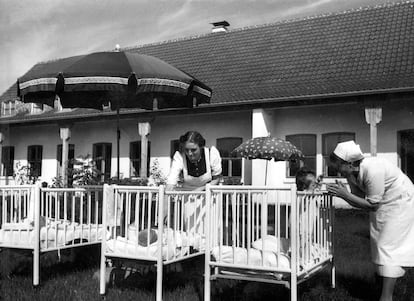
One of the central episodes of the story, which the author uses to reveal the horror of Himmler’s nurseries, is that of a baby, Jürgen (a real case), who is born with “signs of degeneration,” neurological problems, and does not pass the eugenic cut of the Heim, marked by the maternity doctor, Gregor Ebner, a real person with the rank of SS Oberführer and a personal friend of Himmler. The baby is taken from its mother to a hospital for Sonderbehandlung — special treatment — a euphemism for extermination.
The letter in which a colleague tells the nurse Helga how they have proceeded with the baby is chilling. Helga had asked her to find out what became of the child in order to tell the heartbroken mother, and the friend explains with a self-confidence that underlines the moral level of the system: “You can rest easy. I assisted the patient during the merciful disinfection. While I was giving him the medicine to drink, I held him in my arms very carefully and even tenderly. I always hold them like this at such moments. Besides, the morphine prevents them from suffering […] As for his body (the mother asks that they at least let her bury the child), it has been in the hospital laboratory for a long time. There is certainly nothing left of him; nothing distinguishable in any case.” And she adds, instructing Helga: “No culpable weakness. Tell your intern to forget what happened as soon as possible and have more gültig, valid children, for the greater glory of our Reich, Heil Hitler!” In reality, the mother is sterilized, just in case.
“It worked like this; the SS maternity wards were the flip side of the same coin as the Nazi camps,” explains De Mulder, a delicate 48-year-old with a calm attitude whose appearance contrasts with the harshness of the subject of her novel, except for the high black boots she wears. “Although we are shocked by the contrast between the Lebensborn, with their extreme cleanliness, their white clothes and their abundance of food, and the death camps, with their terribly miserable conditions, both facilities responded to the same logic and the same criminal racist program.”
Himmler, who regularly visited camps and maternity wards, showed, as the novelist recalls, great sensitivity in the latter and even cried with emotion at the sight of the Nazi babies. He was the godfather to some of them (those born on his anniversary), and presented them with a dagger. In total, De Mulder notes, he was godfather to some 80 of the 20,000 children raised in the Heime.
In the program for breeding Aryan children, the Reichführer perversely displayed his passionate agricultural side, with a great interest in poultry farming. He graduated in agronomy, was the NSDAP expert on agriculture and national-ethnic peasant politics, and always displayed interest in the subjects of manure, sowing, and fertilization, which became intertwined with his theories on race and inheritance. Himmler, as he did with everything else under his control, exhaustively and morbidly regulated the operation of the maternity wards, applying his criteria for child-rearing and diet. In the novel, we see him recommending oatmeal and worrying that births in the maternity wards will not cover the heavy losses of the grenadiers in his SS Panzer divisions in Normandy. The Reichsführer came to calculate that each SS battalion could provide him with between 200 and 300 illegitimate children a year.
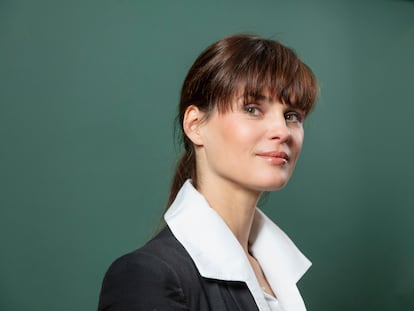
“Despite their familiar appearance,” says De Mulder, “the maternity wards were actually very cold, very clinical places. They were basically baby factories, or, yes, farms. There was certainly not much sensuality, and that contrasts with the great fantasy that has been developed around the maternity wards, which presents them as brothels: they were not at all.” The Heime were not, she stresses, recreational harem-like establishments for the SS, or “Kitty Hall.” And the mothers were not SS prostitutes, as they were labeled (or degraded) after the war. In fact, even makeup was banned.
The writer considers the character of Helga (fictional, like the other two narrators) to be crucial in her novel. “She is the main character, she was my starting point because I was very disturbed by ordinary evil. We are more familiar with absolute evil, but ordinary evil — that of those who obeyed, like Helga — is scarier. It shows you to what extent we all swing between good and evil. I didn’t want a heroine, most people are not heroes.” Helga is indoctrinated — in the Heim, Mein Kampf is read aloud — but she is not blind and she questions herself while she censors herself for what she thinks. “I don’t mind the reader identifying themselves to a certain extent and wondering what they would have done in that situation; it leads to reflection and being attentive.”
The entire Nazi maternity ward program was permeated by the chauvinism inherent in the regime of confining women to Kinder und Kuche (children and kitchen) and Kammer (bedroom). “Yes, of course, the fundamental role of women in the Third Reich was to procreate, the Heim was an instrumentalization of the woman’s womb. The women in the maternity wards were not victims but volunteers, but there was an appropriation of their gestation and its outcome.” What did Hitler himself think of maternity wards? “I have not found any reference in his speeches, it was a matter for Himmler, he was the creator, the instigator. Hitler was in favor, of course, because nothing was done in Germany without his approval. We find a parallel again with extermination, where it is Himmler who gets his hands dirty.”
What happened to the children in the maternity wards after the Nazi defeat “is not the subject of the novel, but it is very well-documented. They often had very hard lives,” says the author. “There was a lot of dispersion, they were hidden away so as not to be subjected to public scrutiny and judgment, although many later sought out their origins. They were all stigmatized: they were Nazi babies. In some countries such as Norway, where there were 10 maternity wards, because of the racial interest that the Nazis gave to Norwegians and because of the large number of German soldiers stationed in the country, they have been a taboo and a national problem. The children in the maternity wards in general are the last recognized victims of the Second World War. They were regarded as Nazi super-babies from the baby factory and were even labelled as bastards raised like piglets, but they were victims.”
The program, she points out, began in 1935, so the oldest were only 10 years old when the war ended. “The idea was that the little super-Aryans would be future warlords, they would be the elite rather than cannon fodder. The real father was considered to be the state, hence the ceremonies held after their birth, which were the SS equivalent of baptism, the feast of Namesgebung, the blessing of the name.”
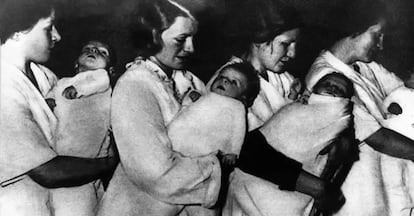
Related to the same Nazi breeding program, and a subject that De Mulder touches on briefly in her book, are the kidnappings of children (which Michel Tournier gave a literary account of with his fable of the ogre Abel Tiffauges in The Erl-King), but they respond to a different dynamic. As De Mulder recalls, the Nazis kidnapped approximately 200,000 so-called “racially pure” children from across Europe to assimilate them into German culture.
Despite the flood of information and books about Nazism, De Mulder does not believe that people will tire of it. “We have never recovered from the Second World War and the Holocaust at its heart. The West remains horrified and traumatized by that war and the Shoah. The organization of extermination is absolute evil and we continue, and will continue, to question how it was possible.”
Sign up for our weekly newsletter to get more English-language news coverage from EL PAÍS USA Edition
Tu suscripción se está usando en otro dispositivo
¿Quieres añadir otro usuario a tu suscripción?
Si continúas leyendo en este dispositivo, no se podrá leer en el otro.
FlechaTu suscripción se está usando en otro dispositivo y solo puedes acceder a EL PAÍS desde un dispositivo a la vez.
Si quieres compartir tu cuenta, cambia tu suscripción a la modalidad Premium, así podrás añadir otro usuario. Cada uno accederá con su propia cuenta de email, lo que os permitirá personalizar vuestra experiencia en EL PAÍS.
¿Tienes una suscripción de empresa? Accede aquí para contratar más cuentas.
En el caso de no saber quién está usando tu cuenta, te recomendamos cambiar tu contraseña aquí.
Si decides continuar compartiendo tu cuenta, este mensaje se mostrará en tu dispositivo y en el de la otra persona que está usando tu cuenta de forma indefinida, afectando a tu experiencia de lectura. Puedes consultar aquí los términos y condiciones de la suscripción digital.
More information
Archived In
Últimas noticias
Families demand repatriation of bodies of Colombians who died in Ukraine: ‘This war is a slaughterhouse for foreigners’
James Cameron: ‘For the films I like to make to continue to exist, we have to find a way to make them cheaper’
Helen Levitt, the photographer who captured the theater of the everyday
The guardians of the meteorites of the Argentine Chaco
Most viewed
- Christian Louboutin: ‘Young people don’t want to be like their parents. And if their parents wear sneakers, they’re going to look for something else’
- US sanctions against jailed cartel leader ‘El Marro’ highlight Mexico’s lack of control over its prisons
- Cartels in Mexico take a leap forward with narco-drones: ‘It is criminal groups that are leading the innovation race’
- Liset Menéndez de la Prida, neuroscientist: ‘It’s not normal to constantly seek pleasure; it’s important to be bored, to be calm’
- ‘El Limones’ and the growing union disguise of Mexican organized crime
